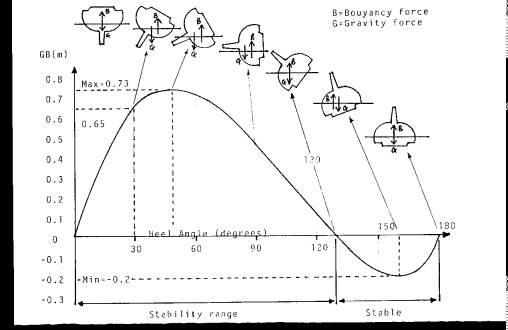Links
Righting Curve for typical Fay Yacht
The righting curve shown (often referred to as the curve of vanishing stability) is actually based on the standard Fay 32. The Fay 36, 40 and 44 are similar.

EXPLANATION
The centre of gravity or mass of a yacht does not move, however the centre of buoyancy does. At rest these two forces are vertically in line and the yacht is stable. As a yacht heels the centre of buoyancy moves out, which can be seen in the drawing. The horizontal distance between these points is known as the righting arm or righting lever. Initially as the yacht heels this becomes longer and the length will depend on the shape of the hull. In the case of the Fay 32 the maximum righting force is reached at around 50 degrees when the arm is 0.73 of a metre long. After this the righting force slowly decreases until at around 130 degrees the yacht begins to enter the inverted stable area.
It has become 'fashionable' to quote the righting curve for a design and many yacht companies are in competition to prove that their yacht has the 'best' righting curve. Some companies are actually including the righting curve of their yachts in their advertisements in yachting magazines. I guess it must help to sell their yachts but it must be taken in context. There are lots of questions about a design that must be answered to enable you to decide on a yacht that suits you and your type of sailing before buying that yacht and the righting curve is only one of them.
The curve shown is for a reasonably stiff cruiser. If the initial rise of the curve is much steeper the yacht may well be too stiff and over responsive, or jerky. This will tend to make the yacht uncomfortable for long passage making. A reasonably steep initial rise is good so that the yacht sails in a fairly comfortable upright manner when going to windward. The Fay 32 shown actually sails to windward best at around 15 degrees of heel. Any more and she becomes over pressed and slows down.
If the initial rise is a lot lower the yacht will be tender and when going to windward will sail with a lot of heel and in all other conditions generally roll a lot. Again this can be uncomfortable.
It can be seen that at around 130 degrees the yacht begins to become stable upside down. Will she self right? -- Think about this.--If the seas are large enough to roll the yacht through 130 degrees they will almost certainly be large enough to roll her through the 50 degrees needed to start her self righting. In reality if a yacht is rolled she will probably have enough kinetic energy to continue all the way round. (Wind alone can not roll a yacht, at most, wind can only contribute to a roll, or cause a knock down, which is when the mast comes close to or actually touches the water.)
A cruising yacht's function is to carry her crew in safety and reasonable comfort. This means that the crew must remain in a fit state to manage the yacht. Therefore, aboard any yacht which is uncomfortable with a difficult motion that causes excessive tiredness, the crew is less safe, even though the yacht itself may have an exceptional righting curve.
The famous sailor and yachting author Eric Hiscock, describes in one of his books making a passage in company with another yacht. The other yacht rolled a little more than his, but this gave a gentler motion and the other crew arrived at the next port in better physical condition with more energy. This led Mr Hiscock to the conclusion that the ultimate righting ability of a yacht is not all that is desirable. (if you can possibly find one, read and treasure Eric Hiscock's 'Cruising and Voyaging Under Sail'.-- Known as the yachtsman's bible. It covers all aspects of good yacht seamanship.)
It seems to me that when looking at righting curves it is sensible to compare yachts. Either read what people report about a design or go sail one and then compare the righting curve to other yachts. To choose the right yacht you must also compare all the other features, such as the fullness of the bow, a too full bow will tend to slam into waves and a slender bow will bury itself into many waves. A large stern may be picked up by following seas too quickly and a slender one over run too often. A lightly constructed yacht with a lot of ballast amidships and little weight in the ends will be great for racing but may be uncomfortably responsive on a long passage.
The righting curve is one value in a yachts design, it is fairly important, but is not the only ultimate criteria preached by some. YOU must decide what features you want and look at available designs that will suit the type of sailing you envisage.
Fay yachts are designed to be good safe cruisers. To be fairly stiff and point well when on the wind. To have a comfortable all round motion. To continually have good performance, even when overloaded for long distance cruising and living aboard. To be fast and comfortable when on those trade wind passages.
ŠPaul Fay 2004